Nainativu Nagapooshani Amman Temple
Nainativu Nagapooshani Amman Temple is one of the ancient and historic temples in Sri Lanka. It is located on the island of Nainativu, Srilanka. During the period of the 9th Century, there lived a Hindu philosopher named Adi Shankaracharya who identified this temple as one of the 64 Shakti Peethas around the globe.
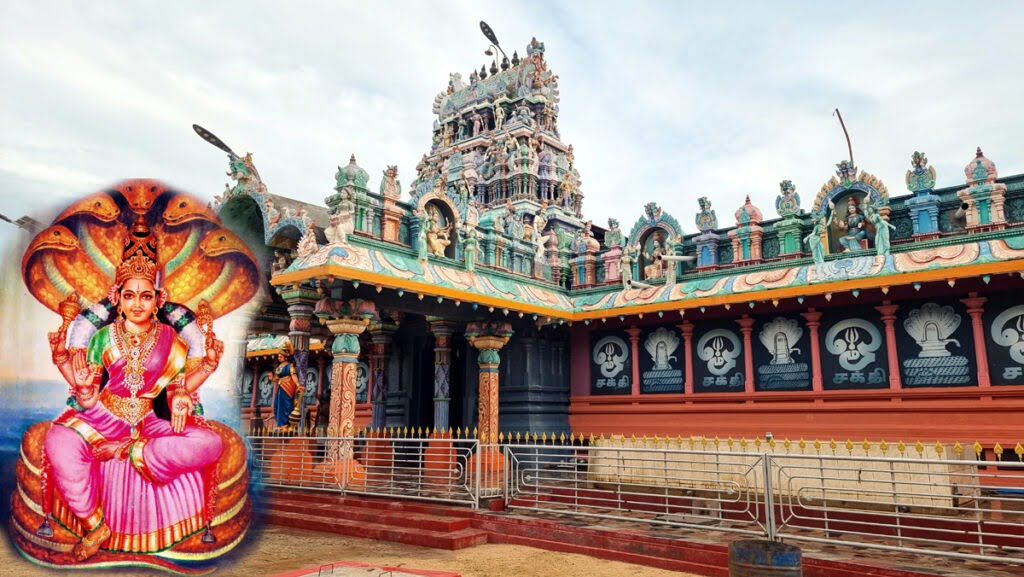
Contents
- 1 Significance of Nainativu Nagapooshani Amman Temple:
- 2 Legend of Nainativu Nagapooshani Amman Temple:
- 3 Architecture of Nainativu Nagapooshani Amman Temple:
- 4 Places to visit near Nainativu Nagapooshani Amman Temple:
- 5 FAQ:
- 5.0.1 Where is the Nainativu Nagapooshani Amman Temple located?
- 5.0.2 What is the significance of the temple?
- 5.0.3 What is the history of the temple?
- 5.0.4 What is the architecture of the temple like?
- 5.0.5 What are the main festivals celebrated at the temple?
- 5.0.6 Are there any restrictions on who can visit the temple?
- 5.0.7 Is there an entry fee to the temple?
- 5.0.8 Is photography allowed inside the temple?
- 5.0.9 How can I reach the Nainativu Nagapooshani Amman Temple?
- 5.0.10 Is there accommodation available on Nainativu Island for pilgrims and tourists?
- 6 How to reach Nainativu Nagapooshani Amman Temple:
- 7 Google Maps:
Significance of Nainativu Nagapooshani Amman Temple:
According to Hindu mythology, Daksha yagna and Sati self-immolation, and as per the texts of Brahmanda Purana, it is the holy place where ” Silambu (Anklets)” fell down. Local people call the deity with the name Nagapooshani or Bhuvaneswari and her concert, the Bhairava form of Lord Shiva is worshiped with the name Nayinaar.
Legend of Nainativu Nagapooshani Amman Temple:
According to the epic Mahabharata, Lord Indra couldn’t overcome his sexual desire for Ahalya, wife of Gautama Maharshi. In order to accomplish his sexual desire, Indra took the disguised form of a saint and started seducing Ahalya. When Gautama Maharshi got to know Indra’s attempt he cursed him to have a thousand marks which resemble yoni (female reproductive organ). Indra was humiliated by the name sa-yoni, unable be bear such humiliation, he started to know what mistake he had made. Seeking mercy, he started praying to Goddess Bhuvaneshwari, queen of the whole universe. Pleased with Indra’s penance and prayer goddess transformed all Yoni’s into eyes.
Nainativu Nagapooshani Amman Temple comprises four gopurams (gateway towers) with each tower touching 20-25 feet, among which eastern Raja Raja Gopuram is 108 feet height. We find such huge towers in Tamil Nadu. When the Portuguese invaded Srilanka (1620) they destroyed the original temple the present structure was built during the period 1720-1790.
As per Nainativu Nagapooshani Amman Temple structure, it was built with Dravidian Hindu Architecture. The structure consists of a beautiful sculpture with oil painting. Approximately it has 10,000 sculptures in this temple. As mentioned above it has four gopurams, Raja Raja gopuram, east, west, and south gopurams.
Because of its scenic and historic presence, this temple is always crowded. On normal days we find a minimum of 1000 people and during festivals, it crosses the 1,00,000 mark. Especially during the month of June/July (Aani month), there are 16 days of Mahotsav (Thiruvizha) which is celebrated with devotion.
Read More: Thanumalayan Temple Suchindram
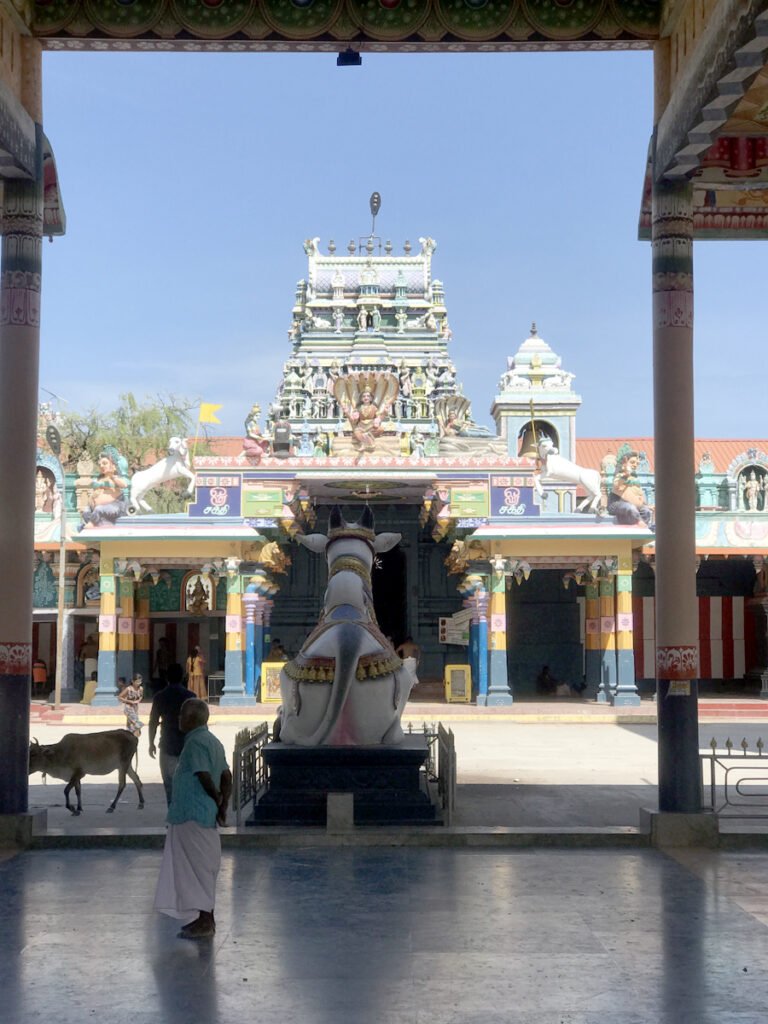
Architecture of Nainativu Nagapooshani Amman Temple:
Gopuram (Entrance Tower): Like many Dravidian-style temples, the Nainativu Nagapooshani Amman Temple typically features a prominent entrance tower or gopuram. This tower is elaborately adorned with intricate sculptures and vibrant paintings. The gopuram is a hallmark of South Indian temple architecture and serves as the main entrance to the temple.
Prakara (Enclosure Wall): Nainativu Nagapooshani Amman Temple is enclosed by a wall known as the prakara, which defines the temple’s sacred precincts. This wall is often decorated with various sculptures and reliefs depicting mythological and religious motifs.
Mandapa (Hall): Inside the temple complex, you’ll find a mandapa or hall. This is a space used for various religious ceremonies, rituals, and gatherings. The mandapa may have pillars and a roof with ornate carvings.
Sanctum Sanctorum: The innermost part of the temple is the sanctum sanctorum, where the main deity, Nagapooshani Amman, is enshrined. The sanctum is considered the most sacred area of the temple and is typically adorned with a decorated inner chamber (garbhagriha) housing the deity’s idol or image.
Idol and Altar: The idol or image of Nagapooshani Amman is the central focus of the temple. It is placed on an altar within the sanctum. Devotees offer prayers and make offerings to the deity at the altar.
Murtis and Statues: Throughout Nainativu Nagapooshani Amman Temple, you will find various murtis (statues) and images of other deities and mythological figures. These sculptures are often carved in stone or wood and are placed in different parts of the temple.
Decorative Elements: The temple’s architecture is known for its intricate and decorative elements. This includes carvings of deities, celestial beings, and floral motifs on the walls, pillars, and ceilings. The use of vivid colors is also common in South Indian temple architecture.
Kodi Maram (Flagstaff): Many South Indian temples, including the Nainativu Nagapooshani Amman Temple, have a tall flagstaff known as the kodi maram in front of the main entrance. It is adorned with a flag or banner, signaling that the temple is open for worship.
Tank or Pond: Some South Indian temples have a sacred tank or pond within the temple complex for devotees to perform ceremonial baths before entering the temple. The presence of a water body may vary from one temple to another.
Read More: Gayatri Shaktipeeth Chitrakoot Temple
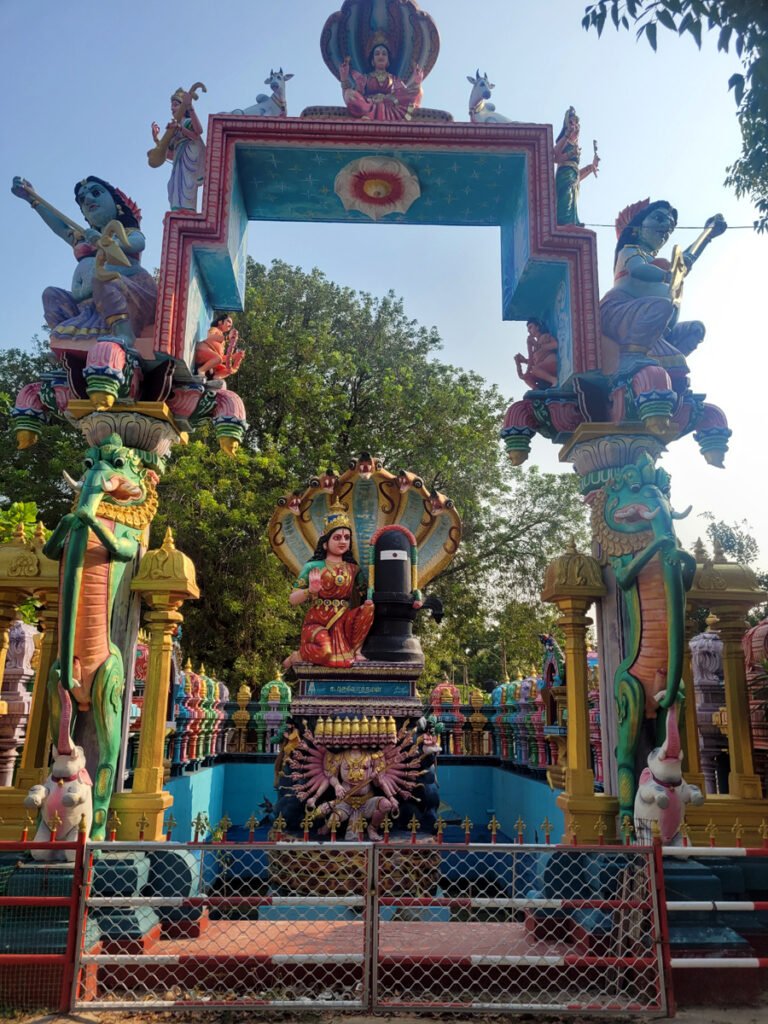
Places to visit near Nainativu Nagapooshani Amman Temple:
Nainativu Island (Nagadeepa Island): Nainativu Island is the location of the Nagapooshani Amman Temple. The island itself is serene and offers beautiful coastal views. You can explore the island’s natural beauty, enjoy the beaches, and take in the tranquil atmosphere.
Nagadipa Purana Vihara: This Buddhist temple is located on Nainativu Island and is historically significant as it is believed to be one of the 16 places visited by Lord Buddha during his three visits to Sri Lanka. Nainativu Nagapooshani Amman Temple has ancient inscriptions and a stupa that pilgrims often visit.
Jaffna: Jaffna is the nearest major city on the Sri Lankan mainland, and it’s known for its rich cultural heritage. Some places of interest in Jaffna include Jaffna Fort, Jaffna Library, Nallur Kandaswamy Temple, and the beautiful Casuarina Beach.
Delft Island (Neduntheevu): Delft Island is not far from Nainativu and is known for its natural beauty. The island is home to wild horses, and you can explore historical sites like the Dutch Fort and the Baobab tree.
Keerimalai: Keerimalai is a coastal village known for its natural springs. The Keerimalai Naguleswaram Kovil, a Hindu temple, is a place of worship and a popular spot for those seeking to take a dip in the sacred waters.
Chundikulam National Park: If you are interested in wildlife and nature, Chundikulam National Park is a bit farther from Nainativu Island but worth a visit. It’s a protected area that’s home to diverse flora and fauna, including a variety of birds.
Jaffna Lagoon: The lagoon in Jaffna is a picturesque water body that you can explore by taking a boat ride. You’ll have the chance to see local fishing activities and enjoy the scenic views.
Dambakola Patuna: This is another historical site associated with Lord Buddha’s visits to Sri Lanka. It is believed to be the place where the Sacred Fig tree sapling was planted by Sangamitta Theri, the daughter of Emperor Ashoka.
Point Pedro: The northernmost point of Sri Lanka, Point Pedro, offers scenic views of the Indian Ocean. It’s a great place to visit for its natural beauty and cultural significance.
Kankesanthurai: This is a coastal town near Jaffna that is known for its beaches and fishing activities. It’s a good place to experience local life and enjoy the coastal scenery.
Read More: Panchsagar Shaktipeeth Uttarakhand
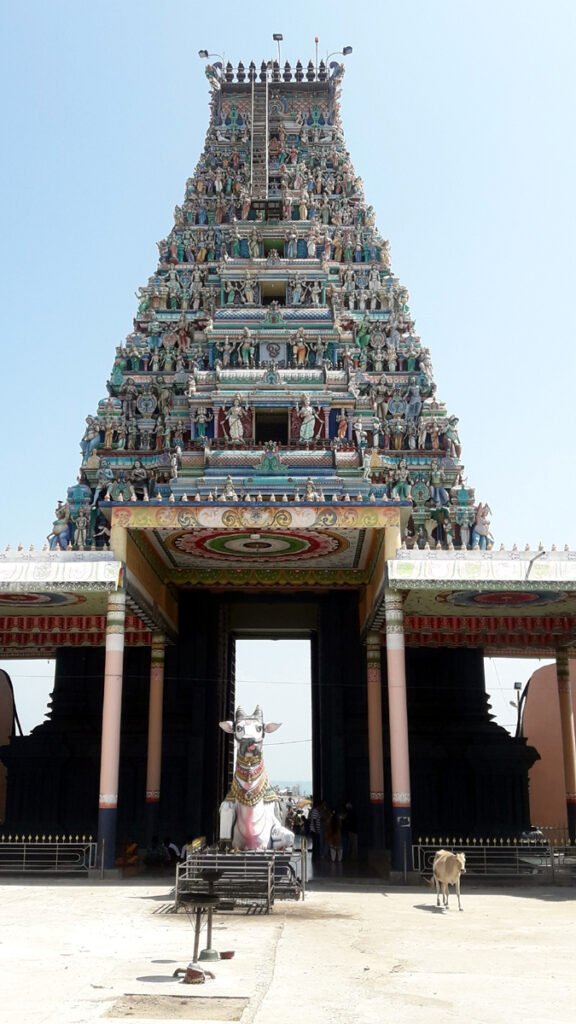
FAQ:
Where is the Nainativu Nagapooshani Amman Temple located?
The temple is located on Nainativu Island, which is one of the smaller islands in the Jaffna Peninsula of northern Sri Lanka.
What is the significance of the temple?
Nainativu Nagapooshani Amman Temple is considered a sacred and important pilgrimage site for Hindus in Sri Lanka and around the world. It is dedicated to Goddess Nagapooshani, who is believed to fulfill the prayers and wishes of her devotees.
What is the history of the temple?
The Nainativu Nagapooshani Amman Temple has a long history, dating back centuries. It is believed to have been originally established by Lord Indra and later expanded by various rulers. The temple has undergone renovations and additions over the years.
What is the architecture of the temple like?
The temple is built in a Dravidian architectural style and features intricate carvings and vibrant colors. The main entrance (gopuram) is adorned with ornate sculptures and artwork.
What are the main festivals celebrated at the temple?
Nainativu Nagapooshani Amman Temple celebrates several festivals, with the annual Masi Magam festival being one of the most significant. During this festival, the deity is taken in a grand procession to the seashore. Other important festivals include Navaratri and Thai Pongal.
Are there any restrictions on who can visit the temple?
The temple is open to all devotees and visitors, regardless of their religious background. However, like many Hindu temples, it is recommended to dress modestly and adhere to traditional temple etiquette.
Is there an entry fee to the temple?
There may be a nominal entry fee for visitors. Nainativu Nagapooshani Amman Temple authorities can provide information about any applicable fees.
Is photography allowed inside the temple?
Photography rules may vary, so it’s advisable to check with the temple authorities regarding photography and videography permissions.
How can I reach the Nainativu Nagapooshani Amman Temple?
To reach Nainativu Island and the temple, you can take a ferry from Jaffna, a major city in northern Sri Lanka. The ferry ride offers scenic views of the surrounding waters.
Is there accommodation available on Nainativu Island for pilgrims and tourists?
There are limited accommodation options on Nainativu Island, including guesthouses and small hotels. It’s recommended to make accommodation arrangements in advance if you plan to stay on the island.
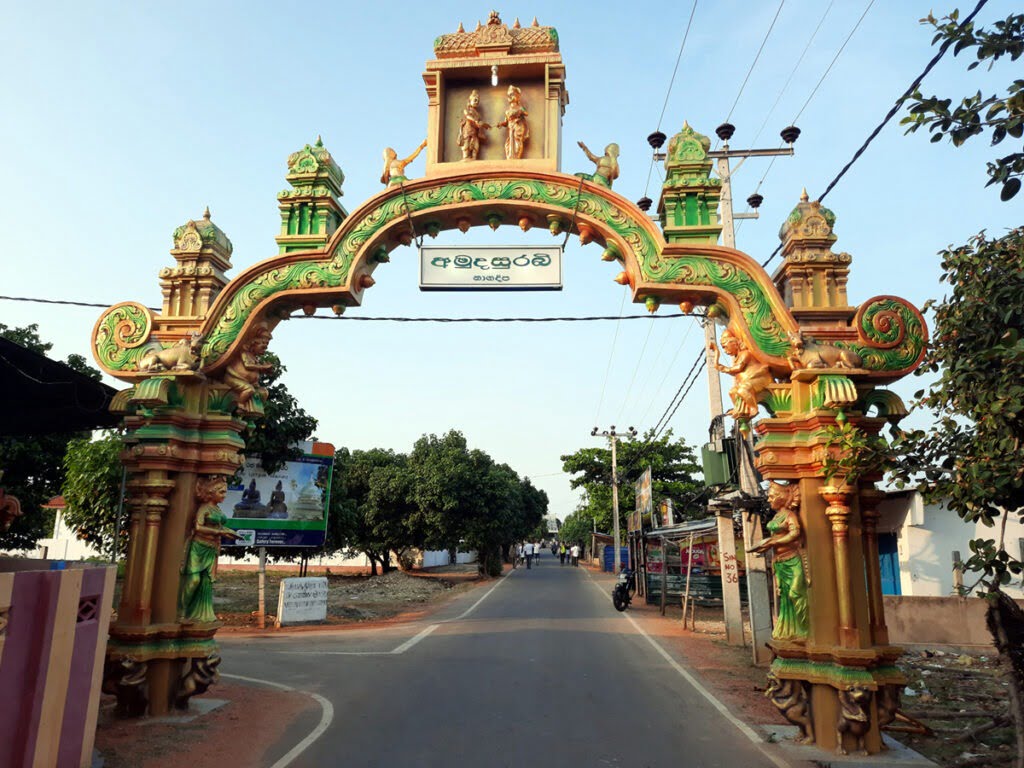
How to reach Nainativu Nagapooshani Amman Temple:
Step 1: Reach Jaffna, Sri Lanka
Your journey begins in Jaffna, a major city in the Northern Province of Sri Lanka. You can reach Jaffna by:
- Air: The nearest airport to Jaffna is Jaffna International Airport (JAF), which is well-connected with Colombo, the capital of Sri Lanka. You can take a domestic flight from Colombo to Jaffna.
- Train: You can also reach Jaffna by train. The Colombo-Jaffna railway line connects the city to Colombo and other parts of Sri Lanka.
- Road: Jaffna is accessible by road from other cities in Sri Lanka. You can take a bus or hire a taxi to reach Jaffna.
Step 2: Reach Nainativu Island
Nainativu Island, where the Nagapooshani Amman Temple is located, is accessible from Jaffna. There are two main options to reach Nainativu Island from Jaffna:
- Ferry: The most common way to reach Nainativu Island is by taking a ferry from Jaffna. Regular ferry services operate between Jaffna and Nainativu. The ferry journey is relatively short and provides scenic views of the region.
- Private Boat: If you prefer a more private and customized experience, you can also hire a private boat to take you from Jaffna to Nainativu Island. This option may be more flexible but can be costlier.
Step 3: Visit Nagapooshani Amman Temple
Once you reach Nainativu Island, you can visit the Nagapooshani Amman Temple. The temple is a significant pilgrimage site for Hindus, and it’s dedicated to the goddess Nagapooshani (a form of Parvati). The temple is known for its historical and religious significance.
Travel Tips:
- Check Ferry Timings: Make sure to check the ferry schedules from Jaffna to Nainativu, as they may vary depending on the season and demand.
- Temple Timings: Be aware of the temple’s opening and closing times to plan your visit accordingly.
- Dress Code: When visiting the temple, adhere to any dress code requirements, which may include wearing modest clothing and covering your head.
- Local Customs: Respect local customs and traditions when visiting religious sites. Remove your shoes before entering the temple premises.
- Weather: Consider the weather conditions, especially during the monsoon season, as ferry services may be affected.
